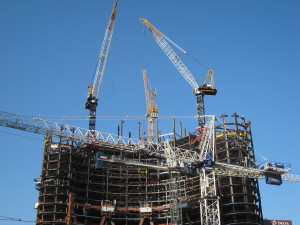Construction claims can be costly for all parties involved. There are the costs of attorney’s and expert witness fees and potentially years of waiting without resolution. There are also more hidden costs to deal with, such as lost management time, impacts on the company’s reputation, and the decreases in team morale as the claim remains unresolved.
It is critical to make sure the damages in a construction claim are calculated and presented correctly to ensure your best chances at negotiating a quick and reasonable settlement. This article deals with the application of some of the most common methods used to prove damages in one of the most common types of claims faced by contractors on construction projects – lost labor productivity claims.
Total Cost Method
With the total cost method, lost labor productivity damages are calculated by comparing the actual costs with the expected or bid costs. The difference between the actual and expected costs is presented as the claimed amount.
It’s also possible to modify the total cost claim by subtracting for bid errors and cost overruns that were not the fault of the other party. This “modified total cost” method is often cited as being more credible than the unmodified version.
Be aware that the total cost method is controversial and sometimes disfavored by courts and boards. To use the total cost method effectively, it should only be used when
- It is impractical to measure losses directly
- The bid price was reasonable
- The actual costs were reasonable (and accurately recorded)
- None of the overruns were the responsibility of the party making the claim
Discrete Cost Approach
With the discrete cost approach, labor costs are tracked and attributed to specific events (using cost codes, labor codes, etc.) and then combined into a lost productivity claim. Compared to other approaches for pricing lost labor productivity damages, discrete methods are generally preferable, provided that the requisite project cost data was collected on the project.
When using the discrete approach, care should be taken to segregate damages (unanticipated or increased costs) from the normal project costs. Discrete approaches are highly effective in pricing direct impact costs but less effective in measuring and estimating the indirect costs associated with certain types of claims.
Measured Mile Method
The measured mile method is the preferred approach to pricing lost labor productivity claims. This method contrasts the contractor’s performance during an impacted period with the contractor’s performance during an unimpacted period on the same project. Labor productivity is measured and calculated for both periods (i.e., square feet of drywall per labor hour, linear feet of underground piping per crew day). The main advantage of the measured mile method is that it does not rely on the bid estimate or “as planned” labor productivity. It measures the actual productivity that was achieved on the project and uses that level as the benchmark in the comparison.
With the measured mile method, care must be taken to ensure that the condition under which the measured work is performed is identical except for the impact on the work that is being blamed for the lost productivity. If a reasonable unimpacted period cannot be identified in the same project (i.e., because the project was at least partially impacted in all areas and at all times), then the analyst may look to comparable projects to draw a comparison.
As with the discrete approach, the measure mile method requires robust project productivity data, which may or may not be available. Care should also be taken to account for other factors that could be affecting productivity such as learning curve, ramp up effects, or weather.
Industry Studies
Industry studies, industry benchmarking, and other similar approaches are generally seen as being less effective than the other methods described above. These approaches are sometimes useful for claims in which the comparative labor costs are non-specialized or highly repetitive, or as objective references when estimating lost productivity on a forward-pricing basis.
Choosing the correct method for calculating damages in a construction claim is a challenging but an essential part of the claim process. It involves collecting, categorizing, and analyzing project costs using the proper methodology to prove the accuracy of the costs being claimed. It also requires a superior understanding of the behavior of costs on a construction project so that the correct and relevant costs are identified and documented.
As discussed above, it is important to take into account the effectiveness and acceptability of the method being used to calculate lost labor productivity claim damages. Since each method has its own strengths and weaknesses, and is accepted to a greater or lesser degree, going with the wrong method for a particular claim can mean a less-than-favorable result. At Carolina Consultants, we are often retained by contractors to review their records and help them choose the best method for calculating lost labor productivity damages on a construction project. If you have a delay or productivity claim contact us today and speak with one of our construction claim specialists. Our claim specialists have focused their careers on solving the most complex construction problems and disputes. Let us put our experience to work to help you find successful resolution to your construction claim.





